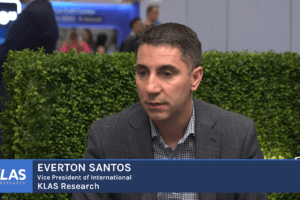The following is a guest blog post by Patty Sheridan, MBA, RHIA, FAHIMA; SVP, Life Sciences at Ciox.
 Technological advances, policy changes and organizational restructures are continuously bringing trends to the healthcare industry, specifically impacting healthcare facilities. Centralization of operations is one of those trends. Driven by a value-based model, the centralization of health information management (HIM) aims to streamline operations, standardize processes, reduce costs and improve quality of care and patient satisfaction.
Technological advances, policy changes and organizational restructures are continuously bringing trends to the healthcare industry, specifically impacting healthcare facilities. Centralization of operations is one of those trends. Driven by a value-based model, the centralization of health information management (HIM) aims to streamline operations, standardize processes, reduce costs and improve quality of care and patient satisfaction.
Oftentimes, HIM departments operate with disparate processes due to legacy standard processes and acquisitions of new entities and are unable to efficiently integrate and access information when it is derived from multiple sources. This causes inconsistencies in processes and procedures, as well as incompleteness of information and unavoidable redundancies. Furthermore, decentralization can result in risks such as ineffective information management, inaccurate coding and breaches.
Silos of information hinder standardization, and as a result create compartmentalized pockets of information from sources, slowing down communication and making change more difficult. However, through the use of electronic HIM technology, secure information can be shared and processed across various departments and facilities at a quicker pace than ever before. Taking these efficiencies one step further, instead of siloes of information, many organizations are moving to a centralized model that can reduce operational costs by streamlining organizational performance, establishing consistent processes through standardization and eliminating redundancies.
Patient health information must be linked across the healthcare continuum to provide the best quality of care. Additionally, sources of information must be linked to electronic health records (EHRs) to support centralization and enhance patient care. To connect silos and reduce risks, healthcare facilities must centralize HIM operations to create standardization and improve coordination across the continuum of care.
Benefits of Centralization
Healthcare facilities can greatly benefit from incorporating the centralization of HIM operations into their long-term organizational plans. In fact, the benefits are greater than any hurdles encountered during the transition. Benefits include:
- Improves operational efficiency: Moving from a fragmented system to a model that streamlines operations improves efficiency and decreases administrative and operational costs.
- Eliminates redundancies and reduces errors: Helps to standardize processes, procedures and forms across a healthcare system to ensure they are the same throughout facilities.
- Improves financial performance: Restructuring improves productivity and efficiency as resources are centrally located, which positively impacts the bottom line.
- Fosters collaboration: Eliminates silos of communication that cause a stagger in the flow of information – improving communications and optimizing patient outcomes.
- Increases accessibility: Provides the benefit of system-wide accessibility to patient information for release purposes, such as billing and coding.
- Optimizes workflow: Allows opportunities to reexamine workflows for optimal efficiencies across the HIM continuum, bringing business value.
Driving Transition Towards Centralization
When an organization transitions to centralized HIM operations, it’s important that the journey be completed with the right preparation and execution. HIM professionals must establish processes that foster opportunities for consolidation and standardization that then result in reduced cost, mitigation of risk and overall improved patient care.
Prior to implementing a centralized model, HIM professionals must take certain steps into consideration:
- Acquire an executive sponsorship to provide direction, support, budget and resolution to potential problems that may arise during the transition.
- Establish a multidisciplinary steering committee to address centralization and your organization’s information policy, aligning resources with strategy.
- Identify challenges, gaps, risks and opportunities while working with collaborators to achieve goals for improvements.
- Define and establish standards, processes and procedures.
Centralization: The Decision is Yours
It is important for HIM professionals to be proactive when determining his or her organization’s vulnerabilities and address them immediately, as breaking down barriers that add risk ultimately drives down costs and improves efficiencies.
Additionally, everyone in an organization may not support the transition. However, executive sponsorship and collaboration between staff, departments and facilities is essential. To gain consensus, HIM professionals must understand the culture of the departments involved and how to leverage their individual technological capabilities.
The work of healthcare professionals is being reshaped by the centralization of HIM operations. If you’re looking to succeed during this ambiguity of change, transforming HIM to a centralized model throughout an enterprise provides healthcare facilities with a competitive advantage, as the integration of emerging technology continues to become a crucial step towards efficient, successful operations.
About Ciox
Ciox is a health technology company working to solve the clinical data illiquidity challenge by providing transparency across the healthcare ecosystem and helping clients manage disparate medical records and is a proud sponsor of Healthcare Scene. When stakeholders do not have timely access to the complete clinical picture of patients, critical decisions about patient care, medical outcomes research, disease prevention, reimbursement, and payments are sub-optimized. Ciox’s scale, expertise, expansive provider network and industry leading technology platform make it the most reliable clinical data company in the US. Through its standards based technology platform, HealthSource, Ciox helps clients securely and consistently solve the last mile challenges in clinical interoperability. Learn more about Ciox’s technology and solutions by visiting www.ciox.com













